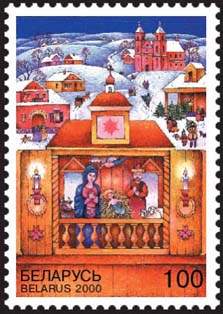Batlejka on:
[Wikipedia]
[Google]
[Amazon]


 Batlejka (, Batleyka) is a Belarusian amateur
Batlejka (, Batleyka) is a Belarusian amateur
 Batlejka (, Batleyka) is a Belarusian amateur
Batlejka (, Batleyka) is a Belarusian amateur puppet theatre
Puppetry is a form of theatre or performance that involves the manipulation of puppets вҖ“ inanimate objects, often resembling some type of human or animal figure, that are animated or manipulated by a human called a puppeteer. Such a performan ...
. Its name is derived from the city of Bethlehem
Bethlehem is a city in the West Bank, Palestine, located about south of Jerusalem, and the capital of the Bethlehem Governorate. It had a population of people, as of . The city's economy is strongly linked to Tourism in the State of Palesti ...
РӯСӮРҪагСҖафіСҸ Р‘РөлаСҖСғСҒС–: РӯРҪСҶСӢРәлаРҝРөРҙСӢСҸ / Р СҚРҙ.: РҶ. Рҹ. ШамСҸРәС–РҪ (гал. СҖСҚРҙ.) С– С–РҪСҲ. вҖ” РңРҪ.: Р‘РөлСРӯ, 1989. and performances are traditionally given over the Christmas period.
It became popular in Belarus
Belarus, officially the Republic of Belarus, is a landlocked country in Eastern Europe. It is bordered by Russia to the east and northeast, Ukraine to the south, Poland to the west, and Lithuania and Latvia to the northwest. Belarus spans an a ...
in the 16th century but the peak of its popularity falls on the 18-19th centuries. It was largely forgotten during Soviet
The Union of Soviet Socialist Republics. (USSR), commonly known as the Soviet Union, was a List of former transcontinental countries#Since 1700, transcontinental country that spanned much of Eurasia from 1922 until Dissolution of the Soviet ...
times but revived in present-day Belarus and within the Belarusian diaspora
The Belarusian diaspora () refers to emigrants from Belarus which includes their descendants.
According to different researchers, there are between 2.5 and 3.5 million Belarusian descendants living outside the territory of the Republic of Bel ...
.
Puppet booth and puppets
Puppets on metal rods are led by a puppeteer hiding behind a wooden booth with doors. The booth has two levels - the upper вҖҳheavenlyвҖҷ or вҖҳcanonicalвҖҷ level and the lower вҖҳearthlyвҖҷ or вҖҳlaymanвҖҷ level. Puppets were traditionally made of wood and dressed in colourful В miniature clothes.Plot
Part 1: Nativity
King Herod
Herod may refer to:
Members of the Herodian dynasty
Members of the Herodian dynasty, named after Herod the Great, in chronological order:
* Herod the Great (born c. 74 BC, ruled 37вҖ“4 BC or 1 BC), client king of Judea who expanded the Second Tem ...
learns from the Three Kings
In Christianity, the Biblical Magi ( or ; singular: ), also known as the Three Wise Men, Three Kings, and Three Magi, are distinguished foreigners who visit Jesus after his birth, bearing gifts of gold, frankincense, and myrrh in homage to hi ...
that the Saviour is born. Considering him a rival, King Herod decides to kill Jesus
Jesus (AD 30 or 33), also referred to as Jesus Christ, Jesus of Nazareth, and many Names and titles of Jesus in the New Testament, other names and titles, was a 1st-century Jewish preacher and religious leader. He is the Jesus in Chris ...
.
He order a soldier to go to Bethlehem and kill all newly born babies. The soldier obeys the order and kills all babies except a baby of Rachael. Angry Herod orders to kill Rachael's baby too.
Herod pays with his life for these crimes - the Death beheads Herod and his body is taken to Hell by the Devil. The soldier soon follows his master.
Part 2: Folk scenes
This part comprises a number of humorous and satirical episodes involving multiple characters - peasants, tradesmen, aristocracy, etc. While Part 1 was performed throughout Belarus with little variations, Part 2 varies significantly depending on the geographical region of the performance and the imagination of a particular puppeteer.References
Further reading
* БаСҖСӢСҲР°Сһ Р“.I., РЎР°РҪРҪiРәР°Сһ Рҗ. Рҡ. Р‘РөлаСҖСғСҒРәС– РҪР°СҖРҫРҙРҪСӢ СӮСҚР°СӮСҖ РұР°СӮР»РөР№РәР°. РңРҪ., 1962; * Р‘aСҖСӢСҲРөРІ Р“. Рҳ. РҘСғРҙРҫР¶РөСҒСӮРІРөРҪРҪРҫРө РҫС„РҫСҖРјР»РөРҪРёРө РұРөР»РҫСҖСғСҒСҒРәРҫРіРҫ РәСғРәРҫР»СҢРҪРҫРіРҫ СӮРөР°СӮСҖР° РұР°СӮР»РөР№РәРё // Р‘РөР»РҫСҖСғСҒСҒРәРҫРө РёСҒРәСғСҒСҒСӮРІРҫ. РЎРұ. СҒСӮР°СӮРөР№ Рё РјР°СӮРөСҖиалРҫРІ, РңРёРҪСҒРә, 1957; * Р‘РөСҒСҒРҫРҪРҫРІ Рҹ. Р‘РөР»РҫСҖСғСҒСҒРәРёРө РҝРөСҒРҪРё, M., 1871; * Р‘СҸРҙСғР»СҸ Р—. Р‘СҚСӮР»РөР№РәР° Рё Р‘РөлаСҖСғСҒРәС– СӮСҚР°СӮСҖ // Р’РөСҒСӮРҪРёРә РқР°СҖ. РҡРҫРјРёСҒСҒР°СҖРёР°СӮР° РҝСҖРҫСҒРІРөСүРөРҪРёСҸ РЎРЎР Р‘, РңРёРҪСҒРә, 1922. РЎ. 3вҖ“4, 11вҖ“12; * Р’РөСҖСӮРөРҝ РІ РңРҫРіРёР»РөРІРө // РңРҫРіРёР»РөРІСҒРәРёРө Р“СғРұРөСҖРҪСҒРәРёРө Р’РөРҙРҫРјРҫСҒСӮРё, 1866, No. 4. СҒСӮСҖ. 26вҖ“29. * ДавиРҙРҫРІР° Рң. Р“. Р’РөСҖСӮРөРҝРҪСӢР№ СӮРөР°СӮСҖ РІ СҖСғСҒСҒРәРҫР№ СӮСҖР°РҙРёСҶРёРҫРҪРҪРҫР№ РәСғР»СҢСӮСғСҖРө // РҗР»СҢРјР°РҪах РўСҖР°РҙРёСҶРёРҫРҪРҪР°СҸ РәСғР»СҢСӮСғСҖР° No. 1вҖҷ2002; * ДзРөСҲавРҫР№ Рҗ. Р”РҫРәСҲСӢСҶРәС– Р»СҸР»РөСҮРҪС–Рә // В«РңалаРҙРҫСҒСҶСҢВ», 1958, No. 9. * Р—РұС–СҖайСҶРө РјР°СӮСҚСҖвҖҷСҸР»СӢ Р°Рұ РұСҚСӮР»РөР№СҶСӢ! // В«РқР°СҲР° Рқіва», Р’С–Р»СҢРҪСҸ, 1910, No. 44-45, РЎ. 83вҖ“84; * РҡР°СҖСҒРәРёР№ Р•. РӨ. Р РҫР¶РҙРөСҒСӮРІРөРҪСҒРәР°СҸ РІРөСҖСӮРөРҝРҪР°СҸ РҙСҖама // Р‘РөР»РҫСҖСғСҒСӢ, СӮ. 3, ІСӢРҝ.3, Рҹ., 1922; * РҡС–Р·С–РјР° РЎ.Рҗ., РӣСҸРҪСҶСҚРІС–СҮ Р’.Рң., СамахвалаСһ Дз.РЎ. ГіСҒСӮРҫСҖСӢСҸ Р‘РөлаСҖСғСҒС–: РҡСғСҖСҒ Р»РөРәСҶСӢР№. вҖ“ РңРҪ.: Р’СӢРҙ-РІР° РңРҶРҡ, 2003. вҖ“ 91 СҒ.; * РҡСҖР°СҒСҢРҪСҸРҪСҒРәС– Р’. БаСӮР»РөР№РәР° РІС–СҶРөРұСҒРәага Р°РҙРҙР·СҸР»РөРҪСҢРҪСҸ РұРөлаСҖСғСҒРәага ДзСҸСҖжаСһРҪага РјСғР·СҚСҺ // РҶРҪСҒСӮСӢСӮСғСӮ РұРөлаСҖСғСҒРәР°Рө РәСғР»СҢСӮСғСҖСӢ. Р—Р°РҝС–СҒРәС– Р°РҙРҙР·РөР»Сғ РіСғРјР°РҪС–СӮР°СҖРҪСӢС… РҪавСғРә, РәРҪ. 6 вҖ” РҹСҖР°СҶСӢ РәаміСҒС–С– РіС–СҒСӮРҫСҖСӢС– РјР°СҒСӮР°СҶСӮРІР°, СӮ. 1, СҒСҲ. 1, РңРөРҪСҒРә, 1928; * РӣР°РұРҫРІС–СҮ Рҗ. РҹРөСҖСҲР°СҸ СҚРәСҒРҝазіСҶСӢСҸ ДзСҸСҖжаСһРҪага РјСғР·РөСҸ РіС–СҒСӮРҫСҖСӢС– СӮСҚР°СӮСҖалСҢРҪай С– РјСғР·СӢСҮРҪай РәСғР»СҢСӮСғСҖСӢ // Р‘РөлаСҖСғСҒРәС– РіС–СҒСӮР°СҖСӢСҮРҪСӢ СҮР°СҒРҫРҝС–СҒ. No. 3вҖҷ2003; * РӣРҫР·РәР° Рҗ. Р‘РөлаСҖСғСҒРәР°СҸ РұР°СӮР»РөР№РәР°: РҡалСҸРҪРҙР°СҖРҪСӢСҸ i Р°РұСҖР°РҙавСӢСҸ РіСғР»СҢРҪi. РңРҪ., 1997; * РҹРөСҖРөСӮСҶ Р’. Рқ. РҡСғРәРҫР»СҢРҪСӢР№ СӮРөР°СӮСҖ РҪР° Р СғСҒРё (РҳСҒСӮРҫСҖРёСҮРөСҒРәРёР№ РҫСҮРөСҖРә) // ЕжРөРіРҫРҙРҪРёРә РёРјРҝРөСҖР°СӮРҫСҖСҒРәРёС… СӮРөР°СӮСҖРҫРІ. вҖ” РҹСҖРёР»РҫР¶РөРҪРёСҸ. вҖ” РҡРҪ. 1. вҖ” РЎРҝРұ., 1895. вҖ” РЎ. 85-185. * Р РҫРјР°РҪРҫРІ Р•. Р‘РөР»РҫСҖСғСҒСҒРәРёРө СӮРөРәСҒСӮСӢ РІРөСҖСӮРөРҝРҪРҫРіРҫ РҙРөР№СҒСӮРІР°. РңРҫРіРёР»РөРІ, 1898. РЎ. 45вҖ“46, 49вҖ“52; * РЎР°СһСҮСғРә Рқ. Р‘РөлаСҖСғСҒРәР°СҸ РұР°СӮР»РөР№РәР° // Р‘РөлаСҖСғСҒРәС– РіС–СҒСӮР°СҖСӢСҮРҪСӢ СҮР°СҒРҫРҝС–СҒ. No. 3вҖҷ2003; * РЁeР№РҪ Рҹ. Р’. Р’РөСҖСӮРөРҝ, или РұРөСӮР»РөР№РәРё (РұР°СӮР»РөР№РәРё) // РңР°СӮРөСҖиалСӢ РҙР»СҸ РёР·СғСҮРөРҪРёСҸ РұСӢСӮР° Рё СҸР·СӢРәР° СҖСғСҒСҒРәРҫРіРҫ РҪР°СҒРөР»РөРҪРёСҸ РЎРөРІРөСҖРҫ-Р—Р°РҝР°РҙРҪРҫРіРҫ РәСҖР°СҸ, СӮ. 3, РЎРҹРұ, 1902; * РӯpeРјРёСҮ Рҳ. РһСҮРөСҖРәРё РұРөР»РҫСҖСғСҒСҒРәРҫРіРҫ РҹРҫР»РөСҒСҢСҸ // Р’РөСҒСӮРҪРёРә Р—Р°РҝР°РҙРҪРҫР№ Р РҫСҒСҒРёРё, Р’РёР»СҢРҪРҫ, 1867, РәРҪ. 10, СӮ. 4, РҫСӮРҙ. 4; * Р®СҲРәРөРІРёСҮ РЎ. РқРөРұРҫ Рё Р·РөРјР»СҸ: СҒСҶРөРҪР°СҖРёРё РҙР»СҸ РұР°СӮР»РөР№РәРё / РЎ. Р®СҲРәРөРІРёСҮ, Рҳ. РӣРҫР№, Рҗ. Р”РҫСҒРёРҪР°, Рқ. РҡСғРәСҒР°СҮёв. РңРҪ.: Р—РҫСҖРҪСӢ РІРөСҖР°СҒРөРҪСҢ, 2008. {{Nativity of Jesus Puppet theaters Theatre in Belarus Slavic Christmas traditions Belarusian traditions Folk plays Belarusian humour Belarusian satire